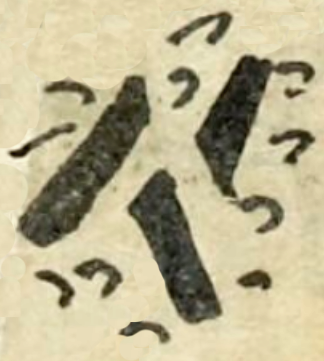Itzehecatl (MH544r)
This black-line drawing of the compound glyph for the personal name Itzehecatl (“Obsidian-Wind,” attested here as a man’s name) shows a frontal view of three black obsidian blades [itztli. Surrounding these are short, black, straight and curving (not quite spiraling, but something like volutes) marks that apparently suggest wind (ehecatl). The multiple markings for ehecatl suggest visible movement. The gloss also provides a redupication of the "e" in the word for wind, which is somewhat unusual in this manuscript, with often uses "ecatl" (air, breath), when it seems to mean wind.
Stephanie Wood
Ehecatl is a day name in the 260-day divinatory calendar (the tonalpohualli), and it is the name of the divine force (deity or divinity) of wind. This combination comprises the name of the sixth level of the underworld in Nahua religious belief. [See: Dominique Raby, “In xochiyecolli, l'épreuve fleurie. Symbolique du genre selon la littérature des Nahua du Mexique préhispanique,” Ph.D. Dissertation, Anthropology, Université de Montréal (2000), p. 203.]
The name in the reverential, Itzehecatzin, was held by a famous Tlaxcaltecatl, and it is still found in use today in Instagram and Facebook. Here, the name was in used by a tribute payer.
John Montgomery drew a group of wind glyphs (possibly mainly Mixtec), showing the variety of ways the blowing device might look. It is published in FAMSI, Inc.
This Nahua name is preceded in the gloss by a Christian first name (Toribio). He may have been named after Toribio de Benavente, also known as Motolinia ("One Who is Poor or Afflicted"). This was the first word he learned in Nahuatl, and he went on to learn the language well. He lived in the monastery in Huejotzingo. Doing a quick search for the name "Toribio" will produce an impressive result.
Stephanie Wood
doribio ytzeecatl
Toribio Itzehecatl
Stephanie Wood
1560
Jeff Haskett-Wood
obsidian, obsidiana, wind, viento, curving, espiral, cuchillos, aire, navajas

itz(tli), obsidian blade, https://nahuatl.wired-humanities.org/content/itztli
ehecatl, wind, https://nahuatl.wired-humanities.org/content/ehecatl
Matrícula de Huexotzinco, folio 544r, https://www.loc.gov/resource/gdcwdl.wdl_15282/?sp=167&st=image
This manuscript is hosted by the Library of Congress and the World Digital Library; used here with the Creative Commons, “Attribution-NonCommercial-ShareAlike 3.0 License” (CC-BY-NC-SAq 3.0).




